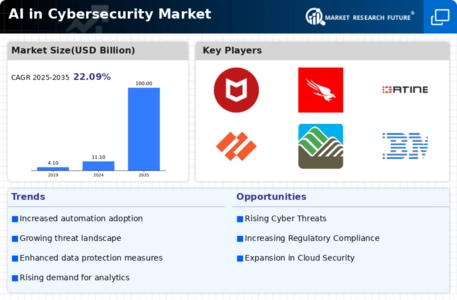Intrusion Detection
Threat Intelligence
Fraud Detection
Security Analytics
Incident Response
Cloud-Based
On-Premises
Hybrid
BFSI
Healthcare
Government
Retail
IT and Telecom
Machine Learning
Natural Language Processing
Deep Learning
Neural Networks
North America
Europe
South America
Asia Pacific
Middle East and Africa
North America Outlook (USD Billion, 2019-2035)
North America AI in Cybersecurity Market by Application Type
Intrusion Detection
Threat Intelligence
Fraud Detection
Security Analytics
Incident Response
North America AI in Cybersecurity Market by Deployment Mode Type
Cloud-Based
On-Premises
Hybrid
North America AI in Cybersecurity Market by End Use Type
BFSI
Healthcare
Government
Retail
IT and Telecom
North America AI in Cybersecurity Market by Technology Type
Machine Learning
Natural Language Processing
Deep Learning
Neural Networks
North America AI in Cybersecurity Market by Regional Type
US
Canada
US Outlook (USD Billion, 2019-2035)
US AI in Cybersecurity Market by Application Type
Intrusion Detection
Threat Intelligence
Fraud Detection
Security Analytics
Incident Response
US AI in Cybersecurity Market by Deployment Mode Type
Cloud-Based
On-Premises
Hybrid
US AI in Cybersecurity Market by End Use Type
BFSI
Healthcare
Government
Retail
IT and Telecom
US AI in Cybersecurity Market by Technology Type
Machine Learning
Natural Language Processing
Deep Learning
Neural Networks
CANADA Outlook (USD Billion, 2019-2035)
CANADA AI in Cybersecurity Market by Application Type
Intrusion Detection
Threat Intelligence
Fraud Detection
Security Analytics
Incident Response
CANADA AI in Cybersecurity Market by Deployment Mode Type
Cloud-Based
On-Premises
Hybrid
CANADA AI in Cybersecurity Market by End Use Type
BFSI
Healthcare
Government
Retail
IT and Telecom
CANADA AI in Cybersecurity Market by Technology Type
Machine Learning
Natural Language Processing
Deep Learning
Neural Networks
Europe Outlook (USD Billion, 2019-2035)
Europe AI in Cybersecurity Market by Application Type
Intrusion Detection
Threat Intelligence
Fraud Detection
Security Analytics
Incident Response
Europe AI in Cybersecurity Market by Deployment Mode Type
Cloud-Based
On-Premises
Hybrid
Europe AI in Cybersecurity Market by End Use Type
BFSI
Healthcare
Government
Retail
IT and Telecom
Europe AI in Cybersecurity Market by Technology Type
Machine Learning
Natural Language Processing
Deep Learning
Neural Networks
Europe AI in Cybersecurity Market by Regional Type
Germany
UK
France
Russia
Italy
Spain
Rest of Europe
GERMANY Outlook (USD Billion, 2019-2035)
GERMANY AI in Cybersecurity Market by Application Type
Intrusion Detection
Threat Intelligence
Fraud Detection
Security Analytics
Incident Response
GERMANY AI in Cybersecurity Market by Deployment Mode Type
Cloud-Based
On-Premises
Hybrid
GERMANY AI in Cybersecurity Market by End Use Type
BFSI
Healthcare
Government
Retail
IT and Telecom
GERMANY AI in Cybersecurity Market by Technology Type
Machine Learning
Natural Language Processing
Deep Learning
Neural Networks
UK Outlook (USD Billion, 2019-2035)
UK AI in Cybersecurity Market by Application Type
Intrusion Detection
Threat Intelligence
Fraud Detection
Security Analytics
Incident Response
UK AI in Cybersecurity Market by Deployment Mode Type
Cloud-Based
On-Premises
Hybrid
UK AI in Cybersecurity Market by End Use Type
BFSI
Healthcare
Government
Retail
IT and Telecom
UK AI in Cybersecurity Market by Technology Type
Machine Learning
Natural Language Processing
Deep Learning
Neural Networks
FRANCE Outlook (USD Billion, 2019-2035)
FRANCE AI in Cybersecurity Market by Application Type
Intrusion Detection
Threat Intelligence
Fraud Detection
Security Analytics
Incident Response
FRANCE AI in Cybersecurity Market by Deployment Mode Type
Cloud-Based
On-Premises
Hybrid
FRANCE AI in Cybersecurity Market by End Use Type
BFSI
Healthcare
Government
Retail
IT and Telecom
FRANCE AI in Cybersecurity Market by Technology Type
Machine Learning
Natural Language Processing
Deep Learning
Neural Networks
RUSSIA Outlook (USD Billion, 2019-2035)
RUSSIA AI in Cybersecurity Market by Application Type
Intrusion Detection
Threat Intelligence
Fraud Detection
Security Analytics
Incident Response
RUSSIA AI in Cybersecurity Market by Deployment Mode Type
Cloud-Based
On-Premises
Hybrid
RUSSIA AI in Cybersecurity Market by End Use Type
BFSI
Healthcare
Government
Retail
IT and Telecom
RUSSIA AI in Cybersecurity Market by Technology Type
Machine Learning
Natural Language Processing
Deep Learning
Neural Networks
ITALY Outlook (USD Billion, 2019-2035)
ITALY AI in Cybersecurity Market by Application Type
Intrusion Detection
Threat Intelligence
Fraud Detection
Security Analytics
Incident Response
ITALY AI in Cybersecurity Market by Deployment Mode Type
Cloud-Based
On-Premises
Hybrid
ITALY AI in Cybersecurity Market by End Use Type
BFSI
Healthcare
Government
Retail
IT and Telecom
ITALY AI in Cybersecurity Market by Technology Type
Machine Learning
Natural Language Processing
Deep Learning
Neural Networks
SPAIN Outlook (USD Billion, 2019-2035)
SPAIN AI in Cybersecurity Market by Application Type
Intrusion Detection
Threat Intelligence
Fraud Detection
Security Analytics
Incident Response
SPAIN AI in Cybersecurity Market by Deployment Mode Type
Cloud-Based
On-Premises
Hybrid
SPAIN AI in Cybersecurity Market by End Use Type
BFSI
Healthcare
Government
Retail
IT and Telecom
SPAIN AI in Cybersecurity Market by Technology Type
Machine Learning
Natural Language Processing
Deep Learning
Neural Networks
REST OF EUROPE Outlook (USD Billion, 2019-2035)
REST OF EUROPE AI in Cybersecurity Market by Application Type
Intrusion Detection
Threat Intelligence
Fraud Detection
Security Analytics
Incident Response
REST OF EUROPE AI in Cybersecurity Market by Deployment Mode Type
Cloud-Based
On-Premises
Hybrid
REST OF EUROPE AI in Cybersecurity Market by End Use Type
BFSI
Healthcare
Government
Retail
IT and Telecom
REST OF EUROPE AI in Cybersecurity Market by Technology Type
Machine Learning
Natural Language Processing
Deep Learning
Neural Networks
APAC Outlook (USD Billion, 2019-2035)
APAC AI in Cybersecurity Market by Application Type
Intrusion Detection
Threat Intelligence
Fraud Detection
Security Analytics
Incident Response
APAC AI in Cybersecurity Market by Deployment Mode Type
Cloud-Based
On-Premises
Hybrid
APAC AI in Cybersecurity Market by End Use Type
BFSI
Healthcare
Government
Retail
IT and Telecom
APAC AI in Cybersecurity Market by Technology Type
Machine Learning
Natural Language Processing
Deep Learning
Neural Networks
APAC AI in Cybersecurity Market by Regional Type
China
India
Japan
South Korea
Malaysia
Thailand
Indonesia
Rest of APAC
CHINA Outlook (USD Billion, 2019-2035)
CHINA AI in Cybersecurity Market by Application Type
Intrusion Detection
Threat Intelligence
Fraud Detection
Security Analytics
Incident Response
CHINA AI in Cybersecurity Market by Deployment Mode Type
Cloud-Based
On-Premises
Hybrid
CHINA AI in Cybersecurity Market by End Use Type
BFSI
Healthcare
Government
Retail
IT and Telecom
CHINA AI in Cybersecurity Market by Technology Type
Machine Learning
Natural Language Processing
Deep Learning
Neural Networks
INDIA Outlook (USD Billion, 2019-2035)
INDIA AI in Cybersecurity Market by Application Type
Intrusion Detection
Threat Intelligence
Fraud Detection
Security Analytics
Incident Response
INDIA AI in Cybersecurity Market by Deployment Mode Type
Cloud-Based
On-Premises
Hybrid
INDIA AI in Cybersecurity Market by End Use Type
BFSI
Healthcare
Government
Retail
IT and Telecom
INDIA AI in Cybersecurity Market by Technology Type
Machine Learning
Natural Language Processing
Deep Learning
Neural Networks
JAPAN Outlook (USD Billion, 2019-2035)
JAPAN AI in Cybersecurity Market by Application Type
Intrusion Detection
Threat Intelligence
Fraud Detection
Security Analytics
Incident Response
JAPAN AI in Cybersecurity Market by Deployment Mode Type
Cloud-Based
On-Premises
Hybrid
JAPAN AI in Cybersecurity Market by End Use Type
BFSI
Healthcare
Government
Retail
IT and Telecom
JAPAN AI in Cybersecurity Market by Technology Type
Machine Learning
Natural Language Processing
Deep Learning
Neural Networks
SOUTH KOREA Outlook (USD Billion, 2019-2035)
SOUTH KOREA AI in Cybersecurity Market by Application Type
Intrusion Detection
Threat Intelligence
Fraud Detection
Security Analytics
Incident Response
SOUTH KOREA AI in Cybersecurity Market by Deployment Mode Type
Cloud-Based
On-Premises
Hybrid
SOUTH KOREA AI in Cybersecurity Market by End Use Type
BFSI
Healthcare
Government
Retail
IT and Telecom
SOUTH KOREA AI in Cybersecurity Market by Technology Type
Machine Learning
Natural Language Processing
Deep Learning
Neural Networks
MALAYSIA Outlook (USD Billion, 2019-2035)
MALAYSIA AI in Cybersecurity Market by Application Type
Intrusion Detection
Threat Intelligence
Fraud Detection
Security Analytics
Incident Response
MALAYSIA AI in Cybersecurity Market by Deployment Mode Type
Cloud-Based
On-Premises
Hybrid
MALAYSIA AI in Cybersecurity Market by End Use Type
BFSI
Healthcare
Government
Retail
IT and Telecom
MALAYSIA AI in Cybersecurity Market by Technology Type
Machine Learning
Natural Language Processing
Deep Learning
Neural Networks
THAILAND Outlook (USD Billion, 2019-2035)
THAILAND AI in Cybersecurity Market by Application Type
Intrusion Detection
Threat Intelligence
Fraud Detection
Security Analytics
Incident Response
THAILAND AI in Cybersecurity Market by Deployment Mode Type
Cloud-Based
On-Premises
Hybrid
THAILAND AI in Cybersecurity Market by End Use Type
BFSI
Healthcare
Government
Retail
IT and Telecom
THAILAND AI in Cybersecurity Market by Technology Type
Machine Learning
Natural Language Processing
Deep Learning
Neural Networks
INDONESIA Outlook (USD Billion, 2019-2035)
INDONESIA AI in Cybersecurity Market by Application Type
Intrusion Detection
Threat Intelligence
Fraud Detection
Security Analytics
Incident Response
INDONESIA AI in Cybersecurity Market by Deployment Mode Type
Cloud-Based
On-Premises
Hybrid
INDONESIA AI in Cybersecurity Market by End Use Type
BFSI
Healthcare
Government
Retail
IT and Telecom
INDONESIA AI in Cybersecurity Market by Technology Type
Machine Learning
Natural Language Processing
Deep Learning
Neural Networks
REST OF APAC Outlook (USD Billion, 2019-2035)
REST OF APAC AI in Cybersecurity Market by Application Type
Intrusion Detection
Threat Intelligence
Fraud Detection
Security Analytics
Incident Response
REST OF APAC AI in Cybersecurity Market by Deployment Mode Type
Cloud-Based
On-Premises
Hybrid
REST OF APAC AI in Cybersecurity Market by End Use Type
BFSI
Healthcare
Government
Retail
IT and Telecom
REST OF APAC AI in Cybersecurity Market by Technology Type
Machine Learning
Natural Language Processing
Deep Learning
Neural Networks
South America Outlook (USD Billion, 2019-2035)
South America AI in Cybersecurity Market by Application Type
Intrusion Detection
Threat Intelligence
Fraud Detection
Security Analytics
Incident Response
South America AI in Cybersecurity Market by Deployment Mode Type
Cloud-Based
On-Premises
Hybrid
South America AI in Cybersecurity Market by End Use Type
BFSI
Healthcare
Government
Retail
IT and Telecom
South America AI in Cybersecurity Market by Technology Type
Machine Learning
Natural Language Processing
Deep Learning
Neural Networks
South America AI in Cybersecurity Market by Regional Type
Brazil
Mexico
Argentina
Rest of South America
BRAZIL Outlook (USD Billion, 2019-2035)
BRAZIL AI in Cybersecurity Market by Application Type
Intrusion Detection
Threat Intelligence
Fraud Detection
Security Analytics
Incident Response
BRAZIL AI in Cybersecurity Market by Deployment Mode Type
Cloud-Based
On-Premises
Hybrid
BRAZIL AI in Cybersecurity Market by End Use Type
BFSI
Healthcare
Government
Retail
IT and Telecom
BRAZIL AI in Cybersecurity Market by Technology Type
Machine Learning
Natural Language Processing
Deep Learning
Neural Networks
MEXICO Outlook (USD Billion, 2019-2035)
MEXICO AI in Cybersecurity Market by Application Type
Intrusion Detection
Threat Intelligence
Fraud Detection
Security Analytics
Incident Response
MEXICO AI in Cybersecurity Market by Deployment Mode Type
Cloud-Based
On-Premises
Hybrid
MEXICO AI in Cybersecurity Market by End Use Type
BFSI
Healthcare
Government
Retail
IT and Telecom
MEXICO AI in Cybersecurity Market by Technology Type
Machine Learning
Natural Language Processing
Deep Learning
Neural Networks
ARGENTINA Outlook (USD Billion, 2019-2035)
ARGENTINA AI in Cybersecurity Market by Application Type
Intrusion Detection
Threat Intelligence
Fraud Detection
Security Analytics
Incident Response
ARGENTINA AI in Cybersecurity Market by Deployment Mode Type
Cloud-Based
On-Premises
Hybrid
ARGENTINA AI in Cybersecurity Market by End Use Type
BFSI
Healthcare
Government
Retail
IT and Telecom
ARGENTINA AI in Cybersecurity Market by Technology Type
Machine Learning
Natural Language Processing
Deep Learning
Neural Networks
REST OF SOUTH AMERICA Outlook (USD Billion, 2019-2035)
REST OF SOUTH AMERICA AI in Cybersecurity Market by Application Type
Intrusion Detection
Threat Intelligence
Fraud Detection
Security Analytics
Incident Response
REST OF SOUTH AMERICA AI in Cybersecurity Market by Deployment Mode Type
Cloud-Based
On-Premises
Hybrid
REST OF SOUTH AMERICA AI in Cybersecurity Market by End Use Type
BFSI
Healthcare
Government
Retail
IT and Telecom
REST OF SOUTH AMERICA AI in Cybersecurity Market by Technology Type
Machine Learning
Natural Language Processing
Deep Learning
Neural Networks
MEA Outlook (USD Billion, 2019-2035)
MEA AI in Cybersecurity Market by Application Type
Intrusion Detection
Threat Intelligence
Fraud Detection
Security Analytics
Incident Response
MEA AI in Cybersecurity Market by Deployment Mode Type
Cloud-Based
On-Premises
Hybrid
MEA AI in Cybersecurity Market by End Use Type
BFSI
Healthcare
Government
Retail
IT and Telecom
MEA AI in Cybersecurity Market by Technology Type
Machine Learning
Natural Language Processing
Deep Learning
Neural Networks
MEA AI in Cybersecurity Market by Regional Type
GCC Countries
South Africa
Rest of MEA
GCC COUNTRIES Outlook (USD Billion, 2019-2035)
GCC COUNTRIES AI in Cybersecurity Market by Application Type
Intrusion Detection
Threat Intelligence
Fraud Detection
Security Analytics
Incident Response
GCC COUNTRIES AI in Cybersecurity Market by Deployment Mode Type
Cloud-Based
On-Premises
Hybrid
GCC COUNTRIES AI in Cybersecurity Market by End Use Type
BFSI
Healthcare
Government
Retail
IT and Telecom
GCC COUNTRIES AI in Cybersecurity Market by Technology Type
Machine Learning
Natural Language Processing
Deep Learning
Neural Networks
SOUTH AFRICA Outlook (USD Billion, 2019-2035)
SOUTH AFRICA AI in Cybersecurity Market by Application Type
Intrusion Detection
Threat Intelligence
Fraud Detection
Security Analytics
Incident Response
SOUTH AFRICA AI in Cybersecurity Market by Deployment Mode Type
Cloud-Based
On-Premises
Hybrid
SOUTH AFRICA AI in Cybersecurity Market by End Use Type
BFSI
Healthcare
Government
Retail
IT and Telecom
SOUTH AFRICA AI in Cybersecurity Market by Technology Type
Machine Learning
Natural Language Processing
Deep Learning
Neural Networks
REST OF MEA Outlook (USD Billion, 2019-2035)
REST OF MEA AI in Cybersecurity Market by Application Type
Intrusion Detection
Threat Intelligence
Fraud Detection
Security Analytics
Incident Response
REST OF MEA AI in Cybersecurity Market by Deployment Mode Type
Cloud-Based
On-Premises
Hybrid
REST OF MEA AI in Cybersecurity Market by End Use Type
BFSI
Healthcare
Government
Retail
IT and Telecom
REST OF MEA AI in Cybersecurity Market by Technology Type
Machine Learning
Natural Language Processing
Deep Learning
Neural Networks

















Leave a Comment